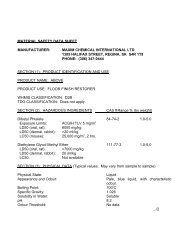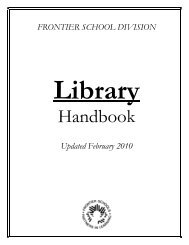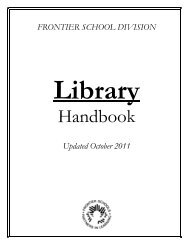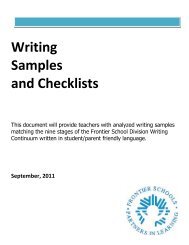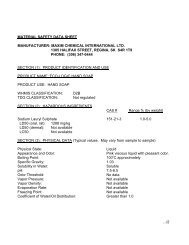Pinchin Indoor Air Quality Investigation Report Letter
Pinchin Indoor Air Quality Investigation Report Letter
Pinchin Indoor Air Quality Investigation Report Letter
You also want an ePaper? Increase the reach of your titles
YUMPU automatically turns print PDFs into web optimized ePapers that Google loves.
Statement of Qualifications – Environmental Due Diligence & Remediation<br />
Human Health and Ecological Risk Assessment in support of a Record of Site Condition under Ontario<br />
Regulation 153/04<br />
Comprehensive RAs are typically undertaken when there is a change in land use and contaminant<br />
concentrations exceed generic site condition standards. They must examine potential risks to human and<br />
ecological receptors and propose risk management measures if necessary. This RA process involves<br />
liaison and approval by the Ontario Ministry of the Environment (MOE).<br />
Due Diligence Risk Assessments<br />
These RAs do not follow the format or scope of work required by the MOE for approval. They may be<br />
conducted solely for the client’s purposes and may involve all or a portion of the site.<br />
Risk Assessment Process<br />
1. Problem Formulation and Conceptual Site Models – The first component of the RA process,<br />
the problem formulation, determines the following:<br />
i. the contaminants of concern (COCs);<br />
ii. potential human or ecological receptors; and,<br />
iii. the exposure pathways by which receptors may come into contact with COCs at the<br />
Site.<br />
The main purpose of the problem formulation stage is to distinguish between issues for which further<br />
quantitative analysis is warranted from those that can be eliminated from further consideration. The<br />
information from the problem formulation stage is summarized in a conceptual site model, which<br />
illustrates the pathways of the COCs from their sources, through the relevant environmental media, to the<br />
receptors of interest.<br />
1. Exposure Assessment Modeling – The second component of the risk assessment, the exposure<br />
assessment, involves estimating the dose of the contaminant received by the receptors for each<br />
relevant exposure pathway identified in the problem formulation. Site-specific data are used to<br />
characterize COC source concentrations (e.g. soil or groundwater concentrations), and reasonable<br />
assumptions are employed to describe potential receptor contact with the COCs.<br />
2. Toxicological/ Chemical Hazard Assessment – The toxicity (or hazard) assessment component<br />
of an RA identifies toxicological reference values (TRVs) for each COC. A TRV is an<br />
acceptable dose or the concentration of a COC that can be suitably tolerated by a receptor without<br />
causing adverse health effects, and is used as a benchmark for comparison with site exposure<br />
during risk characterization. Both the type of health effect (e.g. cancer) and the pathway by<br />
which a chemical comes into contact with the receptor (e.g. inhalation) are considered when<br />
selecting appropriate TRVs.<br />
3. Risk Characterization - The final stage in the RA is risk characterization. The information from<br />
the exposure and toxicity assessments is combined to produce numerical estimates of human and<br />
ecological risk. This step is conducted for all COCs, receptors, and exposure scenarios of<br />
concern. In order to file an RSC, the maximum concentrations of COCs at the Site are compared<br />
to risk-based Property Specific Standards (PSS) to ensure that no residual risks exist at the Site.<br />
Risk management may be required to meet the PSS, and would be described in the form of a Risk<br />
Management Plan (RMP).<br />
4. Risk Communication - It is often necessary to communicate the technical results of a risk<br />
assessment to members of the public with questions about the health of people, animals and<br />
plants at a site. This is often done by preparing a non-technical factsheet of the results and<br />
meeting with residents to answer their questions directly.<br />
Page 6 © <strong>Pinchin</strong> Environmental Ltd.





